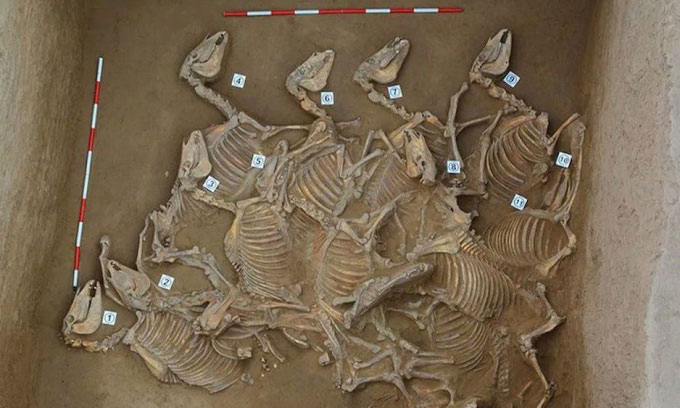Experts discovered city ruins that may have once been a political and cultural center in China with pits containing large amounts of horse bones.
The newly discovered city, called Yaoheyuan , was once surrounded by walls and existed since the Bronze Age, Live Science reported on October 31. This was a thriving political and cultural center during the Western Zhou Dynasty, a period in Chinese history that lasted from 1045 to 771 BC.
 One of six horse sacrifice pits excavated at Yaoheyuan, northwest China. (Photo: Kai Bai/Antiquity Publications Ltd).
One of six horse sacrifice pits excavated at Yaoheyuan, northwest China. (Photo: Kai Bai/Antiquity Publications Ltd).
Yaoheyuan is located at the foot of Liupan Mountain, northwest China. Although there are other Bronze Age sites scattered throughout the area, archaeologists believe that Yaoheyuan may have been the center based on the scale and diversity of the structures excavated.

Human and animal sacrifice was a common practice in Yaoheyuan because the team of experts found many tombs containing dismembered human bones, in addition to horses, cows, goats, sheep, chickens, dogs, and rabbits buried with them. Notably, they discovered 6 sacrificial pits containing horse bones stacked in layers, some of the skeletons were broken into many pieces, showing that they were likely cut off before being thrown down. There were 120 horses in total, including some young animals.

“The consumption of horses and the sacrificial burial pits not only demonstrate the wealth and status of Yaoheyuan but also show the abundance of horses in this area. Horses are one of the most important resources in the west northern China during the Western Zhou period,” the research team wrote. In addition, scientists also unearthed many scattered artifacts such as ceramic molds, stone and jade objects, lacquerware, celadon vases and bones engraved with more than 150 hieroglyphs.

To date, there have been few studies focusing on Western Zhou. Experts need to do further research to understand more about Yaoheyuan’s location during this period and the ancient city’s relationship with other areas in China. “The new findings provide important evidence to examine the political and cultural context of northwest China, and to reassess the relationship between Late Bronze Age cores and surrounding areas. “ , the research team wrote.






